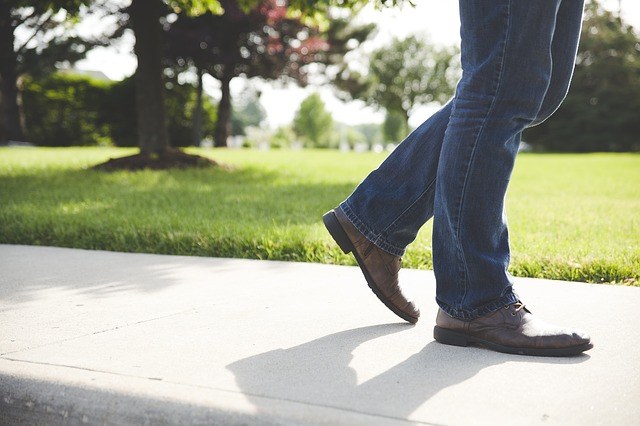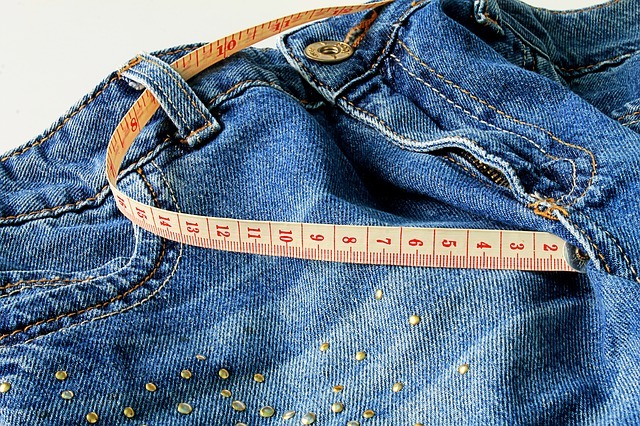Learning how to hem a pair of jeans will save you a lot of time and money after you’ve done your shopping.
Not only will you not have to worry about finding a pair of jeans that fit you perfectly, but you’ll be able to do the alteration work on your own time and dime, as opposed to anyone else’s.

It doesn’t matter whether you prefer to use a sewing machine or to do your sewing by hand; both methods have their benefits!
All that’s important is choosing which method is the best for you.
Supplies for Hemming Jeans
When preparing to hem a pair of jeans on your own, make sure you have the following on hand:
- A heavy duty needle.
- Ruler and a tape measurer.
- Scissors.
- Chalk.
- Thread/floss.
- An iron.
- Ironing board.
- Sewing machine (optional).
Hemming Jeans by Hand Versus Machine: The Debate
When it comes to hemming jeans, you can do the work by hand or use a sewing machine. Sewing machines, naturally, make the job go a bit faster, but it’s also much harder to reverse mistakes made along the way.
Comparatively, hand sewing may be a touch slower, but you can consider your work more carefully and immediately, thereby preventing accidents before they happen.
We’ll address ways to hem jeans using a sewing machine and by hand, so you can decide which method sounds better!
Before You Start Hemming Jeans
Measure the Inseam
Jean alterations should all begin with this basic step, regardless of the method you use to shorten your jeans.
In order to measure your inseam and determine just how much fabric you’ll need to remove from the jeans being altered, find a pair that you know fit you well.
Measure the inseam of these jeans, aligning one end of your tape measurer with the crotch of the jeans and the other with the bottom of the pant leg.
Mark down the length of its fitting inseam on a piece of paper or in your phone. Then, measure the distance between the crotch of the jeans that you intend to alter and those same pants’ hem.
By subtracting the inseam length of the pants that fit, from the inseam length of the pants you’re altering, you’ll be able to find out how much fabric you need to pin or remove from the jeans you’ll be working with. Simple!
Take care, once your math is complete, to use your ruler (or your tape measurer) to map out how much fabric you will need to remove from the jeans you want to alter. Mark the length of fabric with chalk, then prepare your other materials for moving forward.
Cutting or Folding
It’s up to you to decide between cutting away the unnecessary denim or folding it up for alteration.
Cutting away the denim you wish to remove allows you more flexibility with your work, but if you’ve measured incorrectly, you may be in a bit of trouble.
Alternatively, by folding up the denim you wish to remove from your jeans, you’ll be able to alter the jeans’ length and prevent any early mishaps.
It is worth noting that, even as you pin your jeans up, you’ll still be cutting the extra denim away from the jeans. It’s just a matter, really, of deciding when to do that work.
Keep in mind, too: by pinning the extra denim out of the way, it’s more likely that you’ll be able to use the original jeans’ hem when you finish off your project.
Cutting away the extra denim means that you’ll be left with a less polished finish to your jeans or that you’ll be designing a strong hem on your own.
Again, though, deciding whether or not to cut away the extra fabric early on is entirely up to you!
How to Hem Jeans with a Sewing Machine
Looking to hem jeans with a sewing machine?
You’re in luck – so long as you have the right machine feet, you’ll be able to make quick progress on this alteration.
Stitch Your Edges
Once you’ve marked the fabric you want to clear away from your jeans, you’ll be ready to start sewing.
Assuming that you’ve cut off your unneeded fabric, you will begin sewing around the newly raw edges in order to keep them from fraying.
A zig-zag stitch is recommended in order to secure the fabric most effectively.

Straight Stitching
Then, you’ll want to use a straight stitch to sew up the length of each of your pants’ legs.
It doesn’t matter which side of the leg you start on, but you should take care to backstitch at the start and end of your row in order to secure your new hem.
Clean Up
Again, assuming that you cut the extra denim away from your jeans early on, all that will be left is to clean up any stray threads. Then, ta-da! You’ve learned how to shorten jeans!
It’s a task that sounds harder than it is, depending on how you do it.
If you want to keep the professionalism of the pre-done hem, though, the alteration process gets a little more lengthy – but we’ll elaborate on that in a bit.
How to Hem Jeans by Hand
Hand sewing works in much the same way as machine sewing when it comes to hemming a pair of jeans, though hand sewing takes more time than machine sewing does.
If you’re just learning how to hem jeans, then hand sewing will enable you to become intimately familiar with the whole process.
Stitching Your Edges
We will once again assume that you’ve cut away all the unnecessary denim from your jeans.
Instead of finding a zig-zag foot to sew your edges together, you will want to take your heavy duty needle and the thread of your choice, and use both to make invisible backstitches around the diameter of your pant leg.
A general backstitch is achieved by first tying a knot at the end of your thread. Then, begin to form a generally straight stitch around the edge of your fabric.
Since you’ll be working with jeans, in this scenario, you can afford to make bigger stitches; thinner fabrics require tighter stitches in order to keep them from slipping out.
Create a stitch beyond the knotted end of the thread. Then, create your second stitch by taking your needle back to the spot where you tied your thread and stitch forward again.
Repeat this process of one step forward, one step back, until you’ve made it the entire way around your pant leg.
The invisible backstitch is a little more professional than its visible cousin. This stitch is also referred to as the ladder stitch.
Make sure the denim is pressed well, where you want to start sewing. Then, knot the end of your thread.
Bring your needle up through the fabric, effectively hiding the knot as you go. Move your needle to the parallel side of the denim and thread a stitch through a minuscule amount of fabric.
Switch sides again and repeat the process. Then, the entire project becomes repetition until you reach the end of the pant leg.
Clean Up
Creating an invisible backstitch does take a fair amount of time, but once you’re done, all you have to do to finish hemming your jeans is to clean away any loose thread ends that may have gotten away from you.

How to Keep the Original Hem
Let’s say that you’re looking to hem jeans with the original hem. This kind of alteration will leave your jeans looking a little more professional.
The steps require you to leave the fabric of your jeans pinned as opposed to cut, too, thereby allowing you more time to adjust your length before you start removing any denim.
Pinning
Having measured out the amount of fabric you need to remove from your jeans, roll that fabric up and pin your to-be hem into place.
Second Pinning
Place a second row of pins one inch above your original line of pins.
For example: if you want to remove two inches of denim from your jeans, your first line of pins should be two inches above the original hemline.
The second line of pins should be three inches above the original hemline. This second line stands in for the fabric of the original hem and varies based on the amount of fabric designated for that hem.
The majority of jeans use half an inch of denim for their hems; thus, by leaving an extra inch of space on your jeans, you’re making room for that hem’s depth.
Measure your hem in advance and double its length before establishing your second line of pins.
Maneuvering
Remove your first line of pins. Then, roll the fabric of your jeans outward so that the original hem comes into contact with the second line of pins you’ve placed.
Pin the rolled fabric in place, ensuring, as you do, that one side of the hem does not exceed the other in length.
Sewing
Using either a sewing machine or your own needle and thread, sew a line of thread just beneath the original hem along the entire diameter of your pant leg.
Repeat with the second leg as well.
Trimming
Remove the extra fabric from your jeans.
This, as was mentioned earlier, is always where the fabric will be cut if you choose to pin it.
Raw Edges
Using a sewing machine, sew a zig-zag stitch across the freshly cut edges of your jeans.
It is recommended that you use a sewing machine at this stage, though if you choose to hand stitch, you can make use of the invisible backstitch or ladder stitch.
Secure
Take the time to replicate the stitching done on the original hem with a line of thread, doubling the security of your newly hemmed jeans.
You can then repeat this process with the other leg of your jeans, and then you’ll have a fresh set of altered pants that fit you perfectly!
Here’s a video showing an example of this process.
Do you have any tips for hemming jeans?
